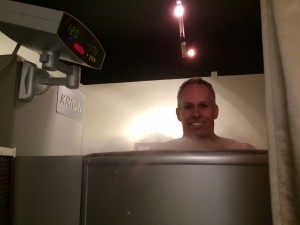Last week I had the opportunity to go and try whole body cryotherapy (WBC). If you're not familiar with what this it's kind of like being in a stand up tanning booth but instead of being strayed with tanning dye you are blasted with nitrogen gas. [caption id="attachment_4794" align="aligncenter" width="300"] 2 mins left at -165 C. Brrrrr!!! In the picture above you can see me standing in the capsule. When you first enter the capsule your head is below the level of the top of the unit. You are then raised up until your head pokes over the top.What you can't see is me in my undies, thermal booties and gloves. The whole process takes 3.5 minutes total. But trust me, you'll want someone else standing there talking to you to distract you from the time remaining. If you're too much of a wimp you can always push open the back door and stop the experience whenever. So what are the purported benefits of WBC? Some of the more popular claims are increased recovery after exercises and how it facilitates rehab post-injury. Since most days involve a training session and I'm currently mending an ACL surgery, it made perfect sense to go and give this a try. While there may be enhanced subjective recovery and decreased muscle soreness the research has yet to come out showing additional benefits (1). At minimum there doesn't appear to any adverse effects to WBC. After the experience I did notice my glutes were cold. And I did feel more alert. I guess this is similar to jumping in the lake this time of year. You will definitely feel refreshed after. If you are interested in knowing more or giving WBC a try, go and talk to the guys at Cryo Care. They're almost next door...
End of the RICE age?
I'm a big fan of systems. And often times systems go hand-in-hand with acronyms. Consider for example that SYSTEM is an acronym for save yourself time energy and money.This can help us remember what to do and ensure that something is done the same way each time.If you played sports growing up there is a good chance you sprained an ankle or had some other type of soft tissue injury at some point. And do you remember what the protocol was for this type of injury?RICE which stands for rest, ice, compression and elevation was the solution to treating our injury and ensuring recovery. More recently there is some debate as to whether this is still the preferred protocol.You don't have to go back many years to when the recommendation for an episode of low back pain was bed rest and ice. Now medical professional will encourage a return to regular activity as soon as it is safe to do so. Which is the opposite of bed rest. Instead the prescription is movement rather than rest.But what about ice?And where does heat factor into this?Let's look at each individually to see what each does for us and come up with a recommended plan for you.ICEWhat it doesThe application of ice is typically used to control inflammation and does so by constricting blood vessels in the vicinity of the cold. There will also be an analgesic (pain relief) effect from the topical application of ice.When it may helpTreatment with cold or ice (cryotherapy) may be beneficial after a heavy lifting session, between training sessions or with an acute muscle injury.How long to useFor an acute joint sprain ice may help in the first 24-48 hours to help reduce inflammation and provide some pain relief. It is important to recognize however that the...
